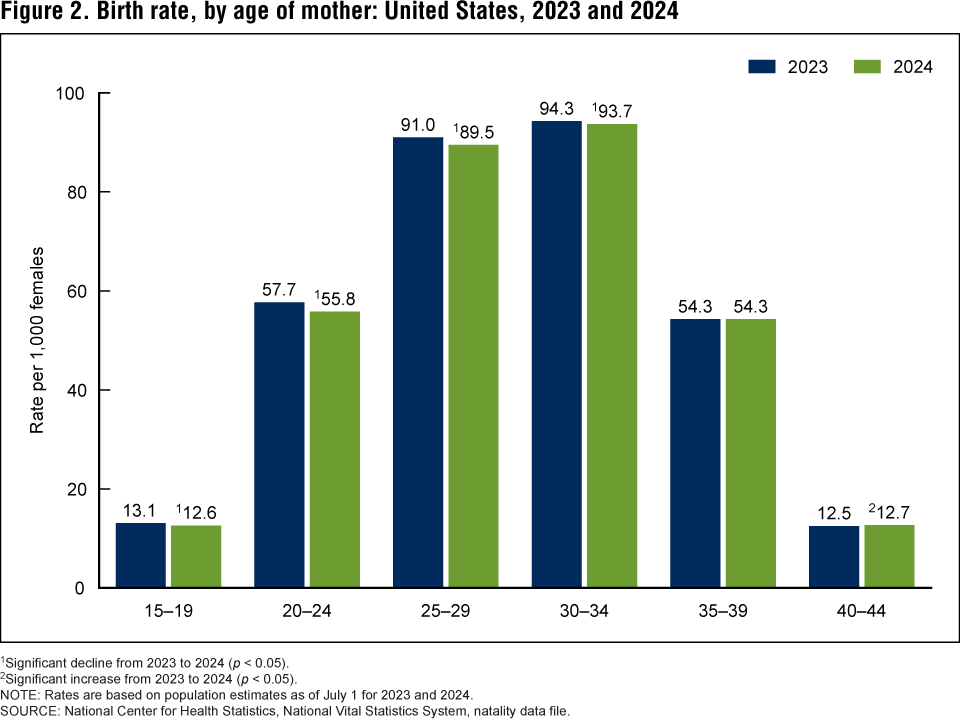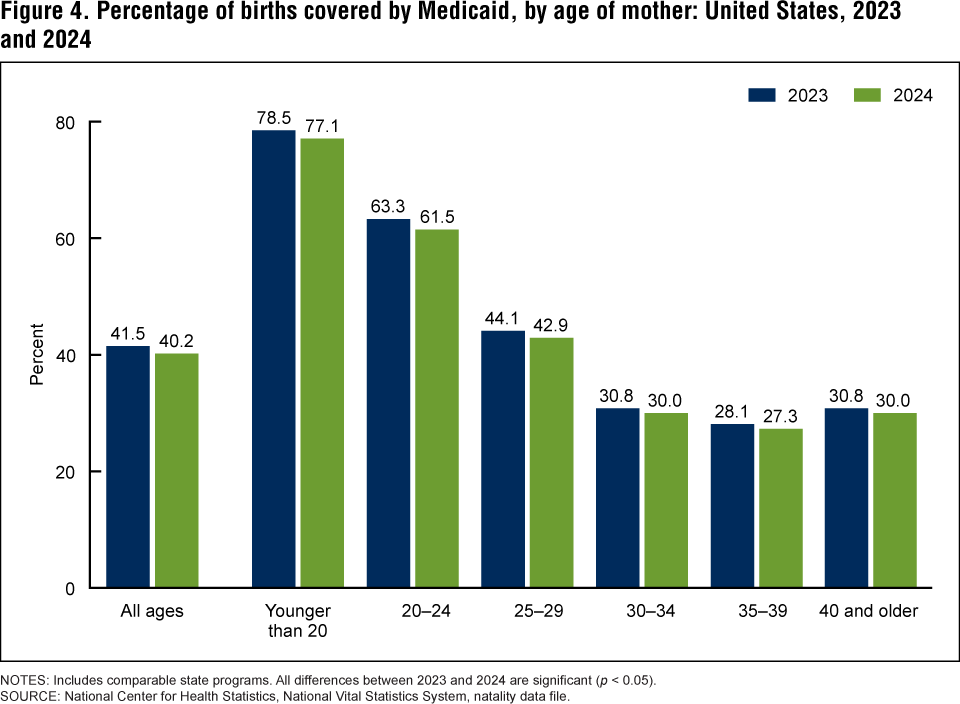Births in the United States, 2024
- Key findings
- The number of births increased from 2023 to 2024, while the GFR declined.
- Birth rates declined for females in age groups 15–34, were unchanged for women ages 35–39, and increased for women ages 40–44 from 2023 to 2024.
- The rate of primary cesarean deliveries increased in 2024.
- The percentage of births covered by Medicaid declined for each maternal age group from 2023 to 2024.
Data from the National Vital Statistics System
- The number of births in the United States increased 1% from 2023 to 2024, to 3,628,934 births.
- The general fertility rate declined 1% from 2023 to 2024 to 53.8 births per 1,000 females ages 15–44.
- From 2023 to 2024, birth rates declined for females in age groups 15–34, were unchanged for women ages 35–39, and rose for women ages 40–44.
- The primary cesarean delivery rate increased to 22.9% in 2024.
- The percentage of mothers for whom Medicaid was the primary source of payment for the delivery declined overall and for each maternal age group.
This report presents highlights from 2024 final birth data on key demographic and medical and healthcare indicators. The number of births, the general fertility rate (GFR) (the number of births per 1,000 females ages 15–44), age-specific birth rates, primary cesarean delivery rates by age of mother, and the percentage of births covered by Medicaid by age of mother are presented. For all indicators, results for 2024 are compared with those for 2023.
Keywords: general fertility rate, primary cesarean delivery, Medicaid, National Vital Statistics System
The number of births increased from 2023 to 2024, while the GFR declined.
- In 2024, 3,628,934 births were registered in the United States, an increase of 1% from 2023 (3,596,017) (Figure 1, Table 1).
- The GFR declined 1% from 54.5 births per 1,000 females ages 15–44 in 2023 to 53.8 in 2024.

Birth rates declined for females in age groups 15–34, were unchanged for women ages 35–39, and increased for women ages 40–44 from 2023 to 2024.
- The birth rate for teenagers ages 15–19 declined 4% to 12.6 births per 1,000 females from 13.1 in 2023 (Figure 2, Table 2).
- From 2023 to 2024, the birth rate for women ages 20–24 declined 3%, to 55.8 from 57.7, and the rate for women ages 25–29 declined 2%, from 91.0 to 89.5.
- The birth rate for women ages 30–34 declined 1% to 93.7 in 2024 from 94.3 in 2023. The rate for women ages 35–39 was 54.3 in 2024, unchanged from 2023.
- The rate for women ages 40–44 increased 2% to 12.7 in 2024, from 12.5 in 2023.

The rate of primary cesarean deliveries increased in 2024.
- The primary cesarean delivery rate increased from 22.8% in 2023 to 22.9% in 2024 (Figure 3, Table 3).
- Primary cesarean delivery rates increased among mothers ages 30–34 (from 23.4% in 2023 to 23.5% in 2024) and 35–39 (26.7% to 26.9%); increases for mothers younger than age 20 and 40–44 were not significant.
- Among mothers ages 25–29, the primary cesarean delivery rate decreased from 21.5% to 21.4%.
- The primary cesarean delivery rate among mothers ages 20–24 was unchanged at 19.7% for both years.

The percentage of births covered by Medicaid declined for each maternal age group from 2023 to 2024.
- Medicaid was the primary source of payment for the delivery for 40.2% of all births in 2024, a decline of 3% from 2023 (41.5%) (Figure 4, Table 4).
- The percentage of births covered by Medicaid declined 2%–3% for all age categories: younger than age 20 (from 78.5% to 77.1%), 20–24 (63.3% to 61.5%), 25–29 (44.1% to 42.9%), 30–34 (30.8% to 30.0%), 35–39 (28.1% to 27.3%), and 40–44 (30.8% to 30.0%).

Summary
U.S. birth certificate data show that, from 2023 to 2024, the number of births increased by 1%, while the GFR declined 1%. From 2007 (the most recent high) to 2023, the number of births has declined 16%; the GFR is down 22% from 2007 to 2024 (1). Age-specific birth rates declined for females in age groups 15–34, were unchanged for women ages 35–39, and rose for women ages 40–44 (1). The rate of primary cesarean deliveries increased in 2024; this rate has risen 6% since the most recent low in 2019 (1). The percentage of births covered by Medicaid declined 3% in 2024 and is down 6% since 2016 (when national data first became available) (2).
Definitions
General fertility rate (GFR): Number of births per 1,000 females ages 15–44.
Birth rates: Births per 1,000 females in the specified age group.
Primary cesarean delivery: Number of births to females having a cesarean per 100 births to women without a previous cesarean.
Medicaid: The primary source of payment for the delivery. Includes comparable state programs.
Data sources and methods
This report uses data from the natality data file from the National Vital Statistics System. The vital statistics natality file is based on information from birth certificates and includes information for all births occurring in the United States. This report accompanies the release of the 2024 natality public-use file (3). More detailed analyses of the topics presented in this report and other topics, such as births by age of mother, tobacco use during pregnancy, pregnancy risk factors, prenatal care timing and use, receipt of WIC food, maternal body mass index, and breastfeeding are possible using the annual natality files (3). Additional information from the 2024 final birth data file and provisional data for 2025 are available via the CDC WONDER platform at https://wonder.cdc.gov/natality.html and will be included in the final 2024 National Vital Statistics birth report.
References to increases or decreases in rates or percentages indicate differences are statistically significant at the 0.05 level based on a two-tailed z test. References to changes in the number of births indicate differences are statistically significant at the 0.05 level based on a two-tailed chi-squared test. Computations exclude records for which information is unknown.
Rates shown in this report are based on population estimates derived from a base that incorporates the 2020 census, vintage 2020 estimates for April 1, 2020, and 2020 demographic analysis estimates. Rates are calculated based on population estimates as of July 1, 2023 (vintage 2023), and July 1, 2024 (vintage 2024) (1,4). The vintage 2024 population estimates include methodological changes made after the release of the vintage 2023 population estimates and projection (5,6). Changes in rates from 2023 to 2024 reflect changes in births and changes in population estimates.
Differences between the rates published in “Births: Provisional Data for 2024” (7) and in this report (both overall and age specific) are largely due to the differences in population estimates and not to differences in the number of births. The rates in “Births: Provisional Data for 2024” are based on vintage 2023 short-term projections for July 1, 2024, population estimates (6), while the rates in this report are based on vintage 2024 population estimates for July 1, 2024 (5) (not available when the 2024 provisional data were published).
About the authors
Joyce A. Martin, Brady E. Hamilton, and Michelle J.K. Osterman are with the National Center for Health Statistics, Division of Vital Statistics.
References
- Osterman MJK, Hamilton BE, Martin JA, Driscoll AK, Valenzuela CP. Births: Final data for 2023. Natl Vital Stat Rep. 2025 March;74(1):1–99. DOI: https://dx.doi.org/10.15620/cdc/175204.
- Martin JA, Hamilton BE, Osterman MJK, Driscoll AK, Drake P. Births: Final data for 2016. Natl Vital Stat Rep. 2018 Jan;67(1):1–55. PMID: 29775434.
- National Center for Health Statistics. Vital statistics online data portal: Birth data files. Available from: https://www.cdc.gov/nchs/data_access/VitalStatsOnline.htm.
- U.S. Census Bureau. Annual state resident population estimates for six race groups (five race alone groups and two or more races) by age, sex, and Hispanic origin: April 1, 2010, to July 1, 2024. 2025. Available from: https://www2.census.gov/programs-surveys/popest/datasets/2020-2024/state/asrh/sc-est2024-alldata6.csv.
- U.S. Census Bureau. Methodology for the United States population estimates: Vintage 2024. 2024. Available from: https://www2.census.gov/programs-surveys/popest/technical-documentation/methodology/2020-2024/methods-statement-v2024.pdf.
- U.S. Census Bureau. Vintage 2024 release notes. 2025. Available from: https://www2.census.gov/programs-surveys/popest/technical-documentation/methodology/2020-2024/2024-est-relnotes.pdf.
- Hamilton BE, Martin JA, Osterman MJK. Births: Provisional data for 2024. Vital Statistics Rapid Release. 2025 Apr;(38):1–10. DOI: https://dx.doi.org/10.15620/cdc/174587.
Suggested citation
Martin JA, Hamilton BE, Osterman MJK. Births in the United States, 2024. NCHS Data Brief. 2025 Jul;(535):1–8. DOI: https://dx.doi.org/10.15620/cdc/174613.
Copyright information
All material appearing in this report is in the public domain and may be reproduced or copied without permission; citation as to source, however, is appreciated.
National Center for Health Statistics
Brian C. Moyer, Ph.D., Director
Amy M. Branum, Ph.D., Associate Director for Science
Division of Vital Statistics
Paul D. Sutton, Ph.D., Director
Andrés A. Berruti, Ph.D., M.A., Associate Director for Science